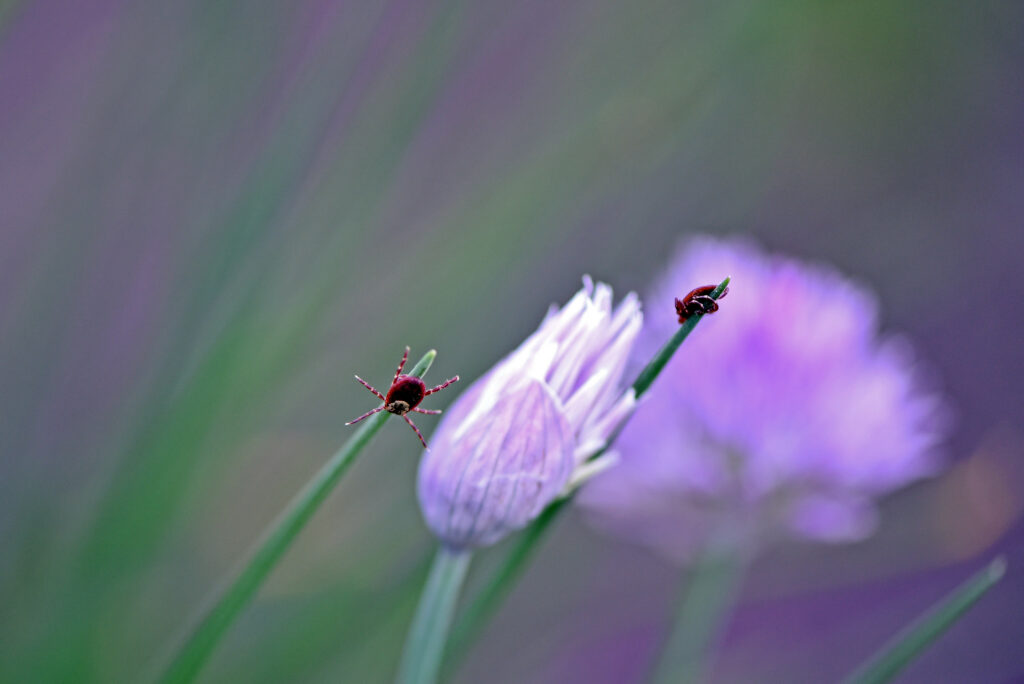Do ticks keep you from enjoying Wisconsin’s great outdoors? We can’t blame you! Of all Wisconsin’s creepy-crawlies, they’re probably the least popular. We hope you’ll feel safer venturing out with these tips on prevention.
Ticks can seem like a nuisance, but they’re a native species and play an important role in Wisconsin’s ecosystems as a food source for other animals, including wild turkeys. The diseases they spread also serve as natural population control for many animals, such as deer, especially with a lack of natural predators.
Ticks thrive in moist, shady environments like woodland edges and tall grass. As winters become milder, their numbers are increasing.
The two ticks you’ll most likely encounter in Wisconsin are the wood tick, which can carry Rocky Mountain Spotted Fever and Tularemia, and the black-legged or deer tick, which is the culprit behind Lyme disease, anaplasmosis, and other tick-borne illnesses. Most disease is spread by the tiny, immature nymphs. The lone star tick is a southern species that has been expanding into Wisconsin, though it is still uncommon here. Its bite can carry Erhlichiosis and Tularemia, and cause an unusual reaction: a red meat allergy.
To keep yourself safe from ticks, here are five steps you can follow:
- Use repellent on skin and clothing. Most commercial insect repellent will keep ticks away, but be sure to check the label. Lemon eucalyptus oil is a natural repellent option as well, although it should not be used on children under three. You may have also heard of permethrin, a pesticide that kills ticks on contact. You can apply permethrin to clothes, shoes, and gear at home, following the CDC’s safety guidelines here. Read the labels carefully if you have pets.
- Wear the right clothes. Long sleeves tucked into long pants tucked into long socks is the best way to keep ticks from reaching your skin. We promise, it is NOT a silly look! Your fellow outdoors folk will admire your foresight. Light colors also make ticks easier to spot and remove.
- Stay out of tick habitat. Avoid bushes and tall grass. Walk on the middle of trails to keep from brushing against vegetation.
- Check for ticks after going outdoors. Search yourself for ticks and take a shower soon after getting in from the outdoors. If you’re worried that ticks might be lurking in your clothes, putting them in the dryer on high heat for 10 minutes will kill any hitchhikers.
- Remove ticks the right way. If you find a tick that has bitten you, don’t panic! As soon as possible, use tweezers to grasp the tick close to the skin and pull upward with steady, even pressure until the tick comes free. Wash the bite area and your hands. You will probably get a red, itchy bump that will go away in a few days, like a mosquito bite. A tick needs to be attached for 36-48 hours to transmit Lyme disease, but if you start to get flu-like symptoms and/or a “bullseye” rash, head to the doctor to have it checked out.
If you’re interested in joining a citizen science effort to track and study ticks, check out The Tick App created by researchers at Columbia University and the University of Wisconsin–Madison.
The CDC also has some good tips on preventing tick bites.
Be tick aware and tick prepared, and you can enjoy Wisconsin’s great outdoors with confidence!
Photo by Courtney Celley with USFWS – Midwest Region.



